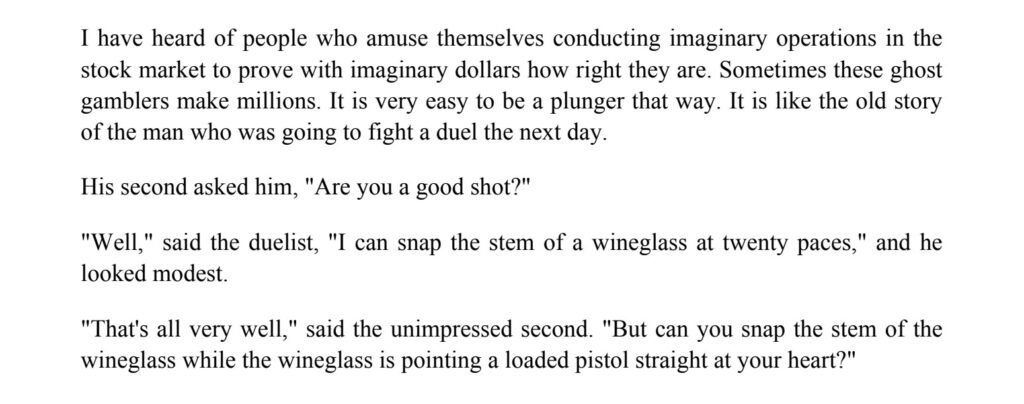Regarding Paper Trading…Below is a quote from “Reminiscences of a Stock Operator” (statement is made by Jesse Livermore) and my comment is below

My response:
True, psychological makeup determines success more than any other factor. Simulated trading differs in the psychological component of trading because having real money at stake causes people to act different. But, everything else is the same.
Managing the psychological component comes with years of experience! But simulated trading is still a challenge. Especially to keep doing it (practicing). And simulated trading teaches habits, like work ethic and non-emotional responses to results. Successful trading takes years of work and practice to learn the tools, trading edges and experience many market environments. Why not form mental habits, muscle memory, so to speak, without money on the line? Many people fail because their bankroll doesn’t outlast their learning curve.
So, Simulated Trading isn’t by any means worthless. Would you tell a musician not to practice if there is no audience present?
Fun Fact: Did you know Jesse Livermore NEVER used charts?
| April 2025 Statistics | Amount | Comments |
|---|---|---|
| Starting Capital | $ 1,000,000 | Disclaimer: Past Performance may not be indicative of future results. Investment Opportunity is closed to the general Public, Open to Private, Accredited Investors Only |
| Gross Profit | $ 429,001 | |
| Commissions & Fees | $ 3,710 | |
| Net Profit | $ 425,291 | Take any investment amount from 0 to $50,000,000 and in general liquidity in markets can support these returns (see stats to the right). Once a certain trading size is reached, performance suffers from managing large amounts. Stock Market Index Futures can handle this liquidity wherease many commodity markets I trade cannot. For example: The notional value traded in 1 day in the S&P Index futures might be $370 Billion, whereas the Coffee market might be $3.7 Billion |
| Total Trades | 66 | |
| Profitable Trades | 40 | |
| Unprofitable Trades | 26 | |
| Win Rate | 61 % | |
| Average Winner | $ 12,473 | |
| Avg Loser | $ (6,662) | |
| Average Trade Profit | $ 6,444 | (Total Profit/Total Trades) |
| Largest Losing Day | $ (35,337) | This could be considered the largest expected drawdown, as a measure of risk. In other words, a account decline of 3.5% would be expected. There might be months where the drawdown could be higher, such as 5-7%. But those days would be rare, maybe happening once every 3 months |
| Largest Winning Day | $ 183,339 | Making 18% in one day would also be rare. This large gain can be attributed largely to one position in Gold and one in the Euro, which are correlated markets, during a time of market volatility. But these types of gains would also happen be expected to happen on occasion. |
| Average Day | $ 20,252 | Average Day including days I took off. I took off 7 trading days. One day was a market holiday but the others were necessary to refresh my brain after stressful days and would be expected to occue with frequency. I’ve learned that it’s more important to stay fresh. |
| % Return (Monthly) | 43 % | |
| Annualized Return | 7000 % | Compounding is powerful, and in this example, would mean re-setting the number of contracts traded based on volatility calculations I use at the end of each month, thereby constantly increasing the number of contracts traded as the account size increases. In practice this large of a return over a long period would be unlikely as liquidity and psychological considerations would affect it |
| Annualized Profit with Monthly Compounding | $ 70,000,000 | Liquidity and the Psychological desire to take less risk the larger the account becomes makes this an unreasonable expectation. I only need $5 Million to Retire |